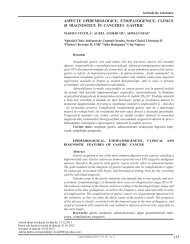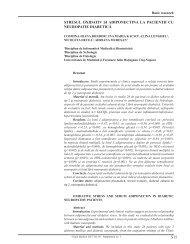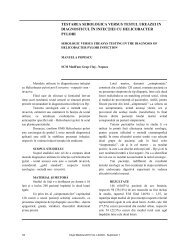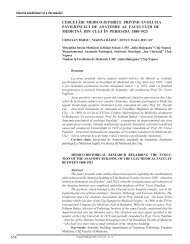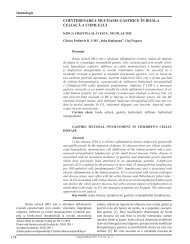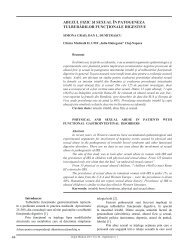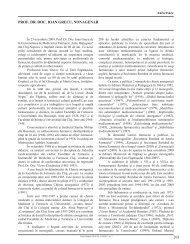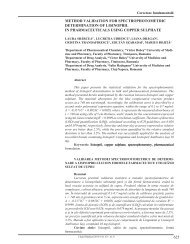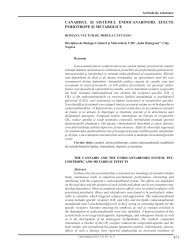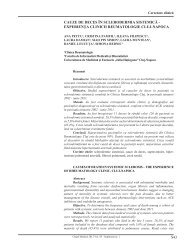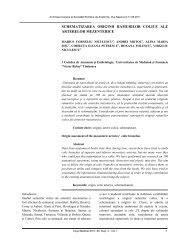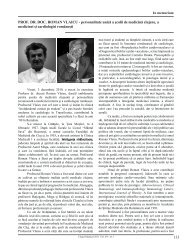You also want an ePaper? Increase the reach of your titles
YUMPU automatically turns print PDFs into web optimized ePapers that Google loves.
<strong>Clujul</strong> <strong>Medical</strong> 2006 vol. LXXX - nr. 1<br />
establised connective-tissue disease. The differential diagnosis included: systemic lupus<br />
erythematosus, systemic sclerosis, rheumatoid arthritis, dermatomyositis and mixed<br />
connective tissue disease. In order to better differentiate, it would have been useful to<br />
measure separately, the titer of the anti-RNP and anti-Sm antibodies.<br />
The treatment we initiated consisted of: corticotherapy (Metilprednisolon 32<br />
mg/day), hepatotrophic therapy, antibiotic treatment (for the urinary tract infection),<br />
local oral antimycotic and antihypertensive treatment (ACE inhibitor + beta blocker +<br />
diuretic). After approximately 1 month of corticosteroid treatment the evolution was<br />
excellent: remission of subjective clinical complaints, improved general status,<br />
apyrexia, the disappearance of oral ulcerations and skin lesions, the regression of<br />
hepatomegaly, the remission of ascites and pleurisy but the persistence of the pericardial<br />
effusion. The humoral parameters improved ( ASAT = 121 U/l, ALAT = 68 U/l, CPK =<br />
220 U/l, 24-hour urine proteins = 0,36 g/24 h, ANA = positive - 1/640).<br />
The overall prognosis for UCTDs is better than that of other connective tissue<br />
diseases. UCTD may remit permanently, progress to an established connective tissue<br />
disease, or remain a stable chronic phase. In our case, the long term prognosis of the<br />
patient is reserved due to the multi-organic dysfunction.<br />
Discussion<br />
The term “connective tissue disease” (CTD) includes a heterogeneous group of<br />
conditions characterized by a wide variety of signs and symptoms. It refers to a group of<br />
autoimmune disorders that are classified among the systemic rheumatic diseases and<br />
include systemic lupus erythematosus (SLE), systemic sclerosis (SSc), polymyositisdermatomyositis<br />
(PM-DM), primary Sjögren's syndrome (pSS), primary<br />
antiphospholipid syndrome (APS), mixed connective tissue disease (MCTD), and<br />
rheumatoid arthritis (RA). CTD share a number of epidemiological and immunological<br />
features that suggest a common pathogenetic pathway [1]. Experimental data indicates<br />
that genetic susceptibility to develop an autoimmune disease is multigenic and that<br />
some genetic defects can predispose patients to more than one autoimmune disease [1].<br />
The sharing of immunogenetic markers may lead to the development of common<br />
clinical features. Among these, the most frequent are Raynaud's phenomenon and<br />
arthralgia or arthritis, often associated with the presence of antinuclear antibodies and<br />
rheumatoid factor. Taken together these features constitute a clinical syndrome that can<br />
often represent the onset of a CTD. Nevertheless, it is known that patients presenting<br />
with this syndrome cannot be diagnosed as having a definite CTD. The classification of<br />
pauci-symptomatic conditions of this kind is still a matter of debate among<br />
rheumatologists. To be diagnosed with one of the CTD, a patient must develop some<br />
disease-specific manifestations, or alternatively a combination of nonspecific, but<br />
characteristic findings. Since the majority of CTD-specific features are neither frequent<br />
nor pathognomonic for a single disease, the most common way to identify CTD is to<br />
look at a cluster of clinical and laboratory findings. This is also the major reason why<br />
classification criteria have been developed for CTD [2]. They are referred to as<br />
classification rather than diagnostic criteria [2, 3]. Classification and diagnostic criteria<br />
certainly share a similar aim: to separate subjects with a definite CTD from those<br />
without such CTD, including both patients with difficult to distinguish conditions and<br />
healthy individuals [2]. The difference between them is that diagnostic criteria should<br />
theoretically have 100% sensitivity and specificity while classification criteria may have<br />
less. In conclusion, diagnostic criteria can be applied to every individual case, whereas<br />
classification criteria cannot [2]. Classification criteria are selected by means of<br />
statistical methods to cluster the combination of features to improve sensitivity and<br />
specificity. It is worth noting that the higher the sensitivity and specificity of a<br />
classification criteria set, the smaller the difference will be between diagnostic and<br />
classification criteria. There also exists, however, a group of systemic autoimmune<br />
139



